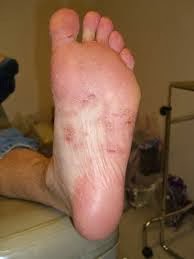Wednesday, October 9, 2013
Socks and Shoes for Athlete's Foot
When you must wear shoes, try for sandals or open-toed shoes. This gives your feet plently of room to breathe. Avoid shoes that are plastic or rubber and water-proof because they will hold moisture in, which is what you don't want if you have a case of Athlete's Foot. When closed toe shoes are necessary stick to the leather (NOT man-made fake leather) becuase leather is a natural substance that also helps feet to breathe.
In terms of socks, cotton is a natural fiber and helps to keep the feet dry. On the other hand, some folks wear by acrylic socks that keep moisture away from the skin. So as far as socks go, it's a toss-up, a personal preference thing.
Monday, September 30, 2013
Can Garlic Cure Athlete's Foot?
It is claimed by naturopaths that garlic can cure Athlete's Foot. Here's the reasoning behind it:
A number of small studies show that garlic, which has been used throughout history for its antimicrobial properties can cure Athlete's Foot. In particular, studies have looked at a compound in garlic known as Ajoene. The compound works effectively against the fungus that causes athlete’s foot.
“Garlic has long been considered a powerful natural antifungal,” said Dr. Lawrence D. Rosen, chief of pediatric integrative medicine at Hackensack University Medical Center in New Jersey and a pediatrician at the Whole Child Center in nearby Oradell. Dr. Rosen pointed out that studies have found garlic effective against a number of fungal infections.
Ajoene creams and solutions are not available commercially. Experts recommend simply adding a few finely crushed cloves of garlic to a foot bath and soaking the affected foot for 30 minutes, or mincing a few garlic cloves, mixing the minced garlic with olive oil, and then using a cotton ball to rub some of the solution on the affected area.
Side effects of garlic are rare -- other thn the smell, of course..
Sunday, September 29, 2013
Chinese Herbal/Natural Cure for Athlete's Foot
Supposedly, this cure works every time, and is simple and inexpensive:
White vinegar, which is anti-fungal and anti-bacterial is the key ingredient to help with Athlete's foot. Soak in this for 20 minutes everyday, pat dry and then sprinkle a mix of powdered Chinese herbs over top. One of the herbs was indigo which works really well (externally) for many types of skin conditions.
Secondly, wear sandals whenever possible, to allow better air circulation to the feet. If you have to wear socks and shoes, make sure the feet stayed dry and that the socks are made of natural materials. Also be sure to dry the feet really well after bathing.
According to this folk-remedy, it works for athlete's foot, but it may take 2-3 weeks to see results.
Thursday, September 19, 2013
WHAT IS ATHLETE'S FOOT, ANYWAY?
Athlete's foot is also known as ringworm of the foot or moccasin foot. It is a fungal infection of the skin that causes scaling, flaking, and itch of affected areas, and sometimes leads to swelling and amputation of the foot. It is caused by fungi in the genus Trichophyton. The disease is typically transmitted in moist communal areas where people walk barefoot, such as showers or bathhouses, and requires a warm moist environment, such as the inside of a shoe, in order to incubate.
The best way to prevent athlete's foot from occuring the first place is to You can prevent athlete's foot bykeeping your feet clean and dry. Also,drying between your toes after swimming or bathing.Wearing leather shoes or sandals that allow your feet to breathe are also helpful.When indoors, try to wear socks (preferrably cotton) without shoes. Be sure to change your socks twice a day.Use talcum or antifungal powder on your feetand and allow your shoes to air for at least 24 hours before you wear them again.Wearing shower sandals in public pools and showers is useful as well.
Thursday, October 25, 2007
Subscribe to:
Posts (Atom)

